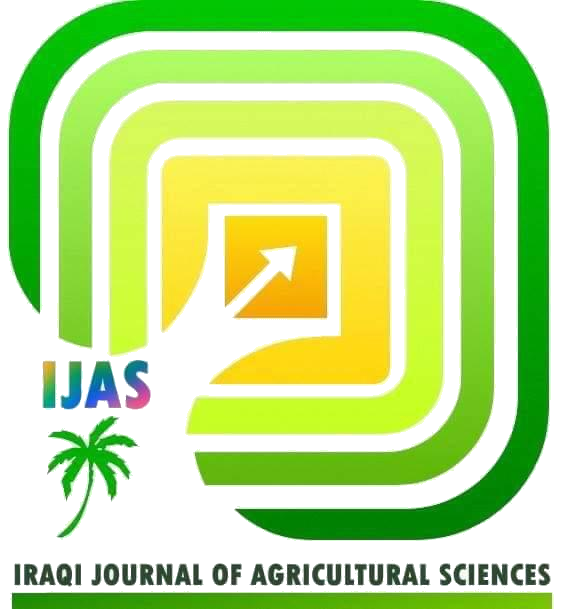GRAIN YIELD OF TWO BREAD WHEAT Triticum aestivum L. VARAITIES UNDER INFLUENCE OF MAGNETIC TECHNOLOGY
DOI:
https://doi.org/10.36103/mzehmf62Keywords:
Bread wheat, magnetized water, grain yield.Abstract
A field experiment was conducted during the 2011-2012 and 2012-2013 seasons at field of State Agricultural Researchers at Abu Ghraib, in order to study the grain yield of two varieties )Triticum aestivum L.) with magnetized water effect. A randomized complete block design was used with three replications.The main plots included (irrigation with magnetized and irrigation with non-magnetized water), and wheat varieties (Fath and Abu Ghraib3) were distributed on sub plots. The results showed that the plants irrigated with magnetize water were superposed in plant height (97.00 and 94.33) cm, (68.48,70.25) for the number of grains.spike-1, weight of 1000 grains.gm (33.64 and 31.18) and grain yield (5.75,5.63) ton.h-1 for the seasons respectively. In addition, the cultivar of the Fath varieties species superposed in most studied traits, giving the highest number of grains.spike-1 (66.62 and 68.08), weight of 1000 grain.gm (33.81 and 30.97) and grain yield (5.79 and 5.48) ton-1 compared with Abu Ghraib 3 cultivar which gave the lowest mean of the traits, while there were no significant differences Between the two varieties in the number of the spike.m-2 at both seasons respectively. The effect of interaction between cultivars and the addition of magnetized irrigation water was significant in the grain yield characteristics of the cultivars. m -2 (491.0 and 483.00), the number of grains.spike-1 (67.97 and 70.50) and grain yield (6.28 and 5.85) tons. h-1 compared to non-magnetized irrigated plants, which gave the lowest mean for the two seasons respectively.
References
1.Abdul, A. H. 2016. Effect of magnetization of irrigation water and grain In some qualities and components of soft wheat Triticum aestivum L. Diyala Journal of Agricultural Sciences 8 (1): 98-91
2.Al-Adjadjiyahn, A. and T. Ylieva. 2003. Influence of Stationary magnetic field on the early stage of the development of tobacco seed (Nicotiana tabacum L.) J.of Central European Agric. 4 (2):131-138
3.Al-Baldawi, M. H. K., 2006. Effect of Planting Dates on Grain Fullness and Average Growth And the Average Growth and Yield and its Components in some Varieties of Bread Wheat. Ph.D. Dissertation. Agriculture college. University of Baghdad.pp.147
4.Al-Hassan, M. F. H., 2011. Understanding the Mechanism of Sub Division in Several Varieties of Bread Wheat Triticum aestivum L. Influenced by Seed Averages and Nitrogen Level and its Relationship with Grain Yield and its components. Ph.D. Dissertation. Agriculture College. University of Baghdad. pp.161
5.Al-Jawthari, H. A. 2006. Effect of Magnetic Adjustment of Irrigation Water and Potassium Fertilizer on Some Chemical Properties of Soil, Growth and Maize Production. M.Sc. Thesis. College of Agriculture . University of Baghdad pp:130.
6.Al-Nakeeb, M.A; A.H. Al-Hilfi and Y.M. Al Kubaisi. 2008. Effect of magnetized irrigation water and phosphater fertilization in the growth and yield of wheat. Anbar Journal of Agricultural Sciences. 6 (2): 96-107
7.Atak,C., O. Emirogla, S. Aklimanoglu. A. and Rzakoulieva. 2003. Stimulation of regeneration by magnetic field in soybean (Glycine max L. Merrill) tissue culture. J. Cell. Mol. Biol. 2:113-119
8.Goodman, E. M., B. Greenbaum and T. M. Morron. 1995. Effects of electromagnetic field on molecules and cells. International Review of Cytol.158: 279-325
9.Hozayn, M. and A. M. Abdul Qados. 2010. Magnetic water application for improving wheat (Triticum aestivum L.) crop production Agric. Biol.J.N.AM. 1(4):677-682
10.Jadouh, K. A. 1995. Wheat Facts and Guidelines. Publications of the Ministry of Agriculture. General Authority for Agricultural Cooperation and Extension pp:20.
11.Kronenberg, K. 2005. Magnetohy-drodynamics: The effect of magents on fluids GMX international
12.Null, G. 2005. Diamagnetic Healing with magnets. http://www.nature salternatives .Com /ic/ mik -esell.html
13.Racuciu, M., D. Creanga and C. Amoraitei. 2007.Biochemical changes induced by low frequency magnetic field exposure of vegetal organism. Rom. J. Phys. 52 (5-7):645-651
14.Selim, M.M.2008. Application of Magnetic Technologies in Correcting Under Ground Brackish Water for Irrigation in the Arid and Semi-Arid Ecosystem. The 3rd International Conference on Water Resources and Arid Environments and the 1st Arab Water Forum
15.Steel, R. G. D. and J. H. Torrie. 1960. Principles and Procedure of Statistics McGraw-Hill Book Co., New York. USA. pp: 481.
16.Stein,G.S. and J. B. Lian. 1992. Regulation of cell cycle and growth control. Bio-electro magnetics Suppl. 1:247-265
17.Tenford, T. S. 1996. Interaction of ELF Magnetic Field with Living System. In: Handbook of Biological Effects of Electromagnetic Field. C. Polk and E. Postow (Eds) 2th ed. CRC Press, pp: 185-230.
18.Thatchenko,U.1997.Hydro magnetic System and their Role in Creating Micro Climate. International Symposium on Sustainable Management of Salt Affected Soil. Cairo, Egypt. pp: 283.
19.Vasileveski, G. 2003. Perspectives of the application of biophysical methods in sustanibale agriculture. Bulg. J. Plant Physiol. 160 (Special Issue): 179-186
20.Wadas,R.S.1992.Bio magnetism.Physics and Its Applications. Ellis Horwood Publ., New York.pp:246
21.Wiersma, D. W., E. S. Oplinger and S. O. Guy. 1986. Environmental and cultivar effects winter wheat response to ethephon plant growth regulator . Agronomy Journal Vol. 78(5): 761-764.
Downloads
Published
Issue
Section
License
Copyright (c) 2025 IRAQI JOURNAL OF AGRICULTURAL SCIENCES

This work is licensed under a Creative Commons Attribution-NonCommercial 4.0 International License.

2.jpg)
 https://orcid.org/0000-0002-5774-5906
https://orcid.org/0000-0002-5774-5906 



